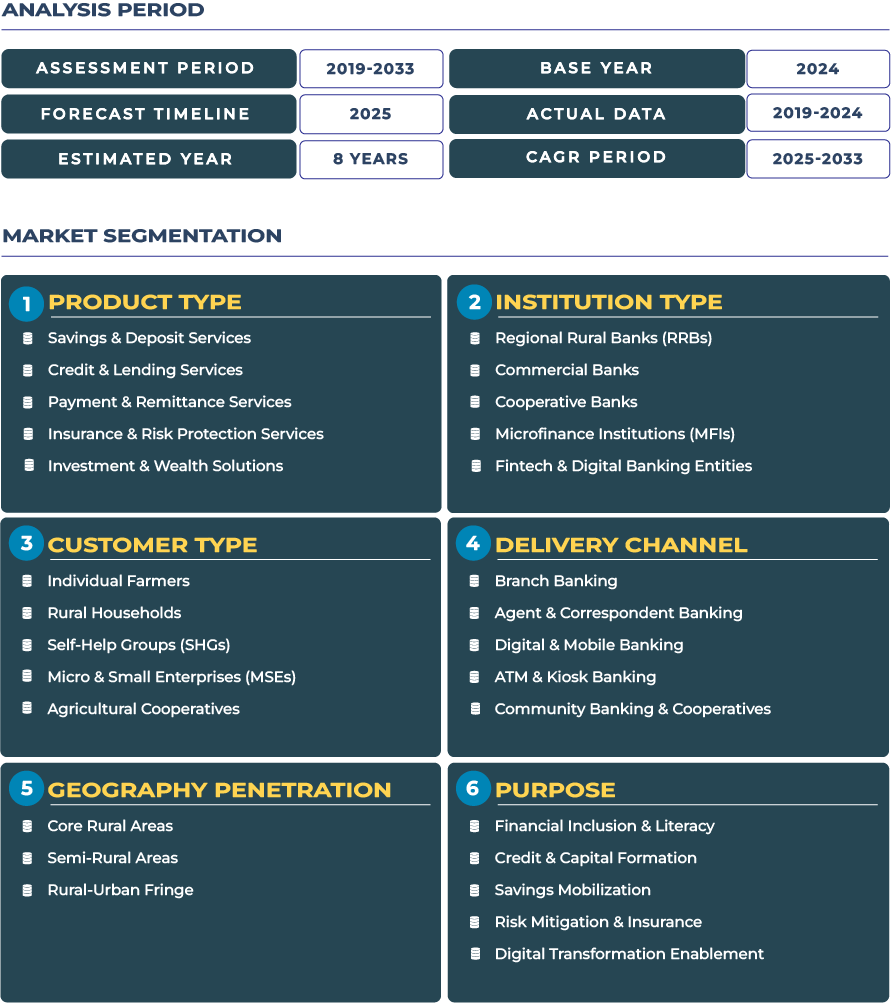Japan’s Aging Rural Communities Redefine Financial Inclusion through Heritage and Asset Revitalization Finance
Japan rural banking market is undergoing a structural transformation as the nation’s aging countryside triggers innovation in inclusive financial models and asset revitalization programs. Traditional banking institutions are increasingly integrating social impact finance, sustainable micro-lending, and heritage asset funding into their portfolios to support depopulated rural regions. As of 2025, the Japan Rural Banking Market is valued at USD 14.6 billion and projected to reach USD 16.4 billion by 2033, expanding at a CAGR of 1.5%. This modest yet steady growth is driven by senior-focused credit programs, digital remittance services for agricultural communities, and government-backed initiatives designed to rejuvenate local economies.
Note:* The market size refers to the total fees/revenue generated by banks through various services.
Banks are extending customized credit and lending services to farmers, small enterprises, and elderly property owners, while insurance and risk protection products are being tailored for agricultural resilience and health coverage. Simultaneously, investment and wealth solutions are being localized through cooperative structures that empower communities to reinvest in regional assets such as abandoned farmland and rural housing stock. These transformations reflect Japan’s broader strategy to maintain economic vitality in its rural heartland.
Japan Rural Banking Market Outlook: How Rural Japan’s Demographic Transition is Fueling New Models of Sustainable Banking
The market outlook for Japan rural banking sector reflects a nuanced balance between demographic challenges and financial innovation. With over 29% of Japan’s population aged 65 or above, according to the Statistics Bureau of Japan, financial institutions are increasingly pivoting toward senior-inclusive lending products, wealth management solutions, and community-based asset revitalization programs. The combination of rural depopulation and an expanding elderly base has compelled banks to create hybrid models that merge traditional savings systems with contemporary digital ecosystems.
Moreover, the government’s Ministry of Agriculture, Forestry and Fisheries has promoted rural revitalization programs that integrate local cooperatives and regional banks, ensuring continued access to essential financial services even in sparsely populated areas. Initiatives promoting cashless payments, micro-investment in agri-ventures, and digital remittance systems have further stimulated rural liquidity. As these strategies mature, the sector’s gradual but sustained growth is expected to bolster both economic inclusion and intergenerational financial resilience.
Drivers & Restraints: How Government Policies and Demographic Realities Are Shaping the Future of Rural Finance
Government Backing and Renewable Energy Investments Empower Rural Banking Expansion
The growth of the rural banking industry in Japan is strongly supported by national policies promoting rural economic sustainability. High investments in renewable microgrids and clean energy financing have opened new lending opportunities for rural banks, enabling them to diversify revenue streams beyond traditional agricultural credit. The Ministry of Economy, Trade and Industry has provided subsidies for green projects, motivating banks to fund rural solar farms and biomass initiatives. These projects not only generate stable loan portfolios but also create employment and infrastructure in depopulating towns, thereby enhancing repayment confidence and regional banking stability.
Demographic Imbalance and Risk-Averse Lending Constrain Market Expansion
However, the sector faces structural limitations. The extremely aging population has diminished the borrower base, with many rural residents depending primarily on pensions rather than business income. This restricts the demand for large-scale lending, compelling local financial institutions to adopt conservative risk frameworks. Additionally, the limited profitability of small-town branches and the slow digital adoption among senior customers pose operational challenges. The shrinking youth population in rural areas further weakens long-term loan prospects, forcing banks to recalibrate their models toward asset-based lending, micro-insurance, and social finance products.
Trends & Opportunities: Transformative Shifts in Japan’s Rural Financial Landscape
Regional Bank Consolidation and Fintech Partnerships Drive Modernization
A defining trend in Japan rural banking landscape is the consolidation of regional banks coupled with increased collaboration with fintech startups. Smaller institutions are merging to achieve economies of scale and to upgrade digital infrastructures that enhance accessibility for elderly clients. Partnerships with payment app providers and community cooperatives have helped introduce mobile savings accounts and telebanking solutions in remote prefectures such as Akita and Kochi. These collaborations bridge generational divides and improve financial literacy through assisted digital onboarding, ensuring that even the most rural communities remain connected to Japan’s evolving financial ecosystem.
Reverse Mortgage Innovations and Vacant Housing Finance Present New Avenues
Emerging opportunities are evident in reverse-mortgage style financial products aimed at elderly landowners. These instruments unlock dormant assets by converting real estate into income streams, enabling rural seniors to sustain livelihoods without selling ancestral properties. For example, in May 2025, a major regional bank launched senior-landowner reverse-mortgage loans across three prefectures, allowing retirees to access liquidity while retaining property rights. Such financial models represent a paradigm shift in how Japan approaches aging demographics and regional revitalization through banking.
Competitive Landscape: How Regional Banks and Government Alliances Are Reshaping Rural Credit Models
Japan’s rural banking ecosystem is anchored by regional institutions such as Japan Post Bank, Norinchukin Bank, and the JA Bank Group, each leveraging digital modernization and asset-based financing strategies. These players are actively launching senior-friendly credit solutions, digital remittance systems, and loan programs for agricultural sustainability. Meanwhile, Norinchukin Bank has increased exposure to renewable energy-backed rural finance, reflecting a nationwide push toward sustainability-driven lending.
The government’s cooperation with private banks continues to foster innovative projects under the Cabinet Office’s Regional Revitalization Strategy. Through these coordinated actions, the rural banking sector is emerging not only as a financial intermediary but also as a social infrastructure player, vital for maintaining Japan’s demographic and economic balance.







